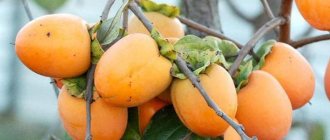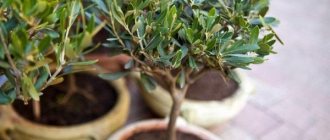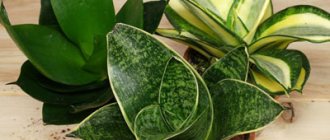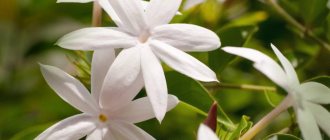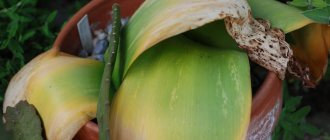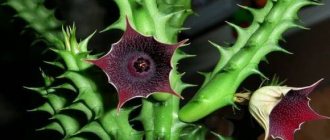How often does a tangerine tree need to be replanted?
1. Each tree expands its territory due to the increase in roots, tangerine is no exception. It needs to be moved from a small pot to a large one. Moreover, this procedure is carried out every year.
2. If we talk about a four-year-old tangerine, it is moved immediately to a wooden tub (pot). Then, within 2-3 years, the tree will successfully bear fruit and develop.
3. The best time to relocate a tangerine is early spring. At this time, citrus awakens. Manipulations begin with a small dig, which is done to check the condition of the rhizomes.
4. If the root system is tightly entwined around a clod of earth, the tangerine requires a transplant. In other cases, it is enough to simply remove the top part of the soil and lay out a new layer. The tree is left in this state for another year.
Preparing the soil for replanting tangerines
In search of an answer to the question of how to care for a tangerine tree, it is recommended to explore the options for land suitable for growing a seedling in a pot. At home, you need to do everything correctly.
So, citrus fruits do not tolerate the acidic environment that accumulates peat. For the tree, you need to choose soft and nutritious soil so that it retains moisture, but at the same time has good air circulation.
To prepare the soil for growing young tangerine trees, prepare a mixture of the following ingredients:
- humus from cow manure;
- turf and leaf types of soil mixed in the same proportion;
- disinfected river sand (coarse).
If desired, you can omit the humus; replace it with compost.
When the tangerine tree reaches the age of 3-4 years, fatty clay is added to the base of the soil. It will prevent the tree's rhizomes from drying out and retain moisture for a long time.
It is imperative to line a layer of drainage about 4-6 cm thick in the pot or tub into which the plant will be transplanted. Clay shards, expanded clay or small pebbles are perfect.
Where do tangerines grow in open ground, what are the popular varieties?
The homeland of mandarin and Southeast Asia. Of all citrus fruits, it is the hardiest, the critical minimum is -8 ° C. Such low frost resistance for Russia, combined with a long (8-10 months, from February to April and November-December) fruit ripening period, greatly limits the possibility of growing oranges in open ground.
In Russia, this crop has successfully taken root and is grown on an industrial scale only in the Krasnodar Territory (Sochi, Adler). Attempts to transfer the plantation to Crimea have not yet yielded positive results. The practice of gardeners on the peninsula indicates that the tree survives and bears fruit only with proper shelter for the winter. On the territory of the former USSR, mandarin, like most of the Georgian and Abkhazian climates.
For gardeners in central Russia and regions with harsher climates, a tangerine tree at the station is still a pipe dream
Russian producers and farmers choose varieties based on the cold:
- Sochi, No. 23 - early tangerines, large, sweet, slightly reminiscent of a pear in shape;
- Pioneer 80 - fruits, medium ripening, flattened, sweet and sour;
- Mandarin Unshiu broadleaf - an early variety, the fruits are large, sweet, flattened, pronounced “belly” from the button;
- Cavanaugh-Bob (Bob Cavanaugh) is a dwarf tree up to 1.7 m high, the fruits are thin-skinned, very sweet and juicy.
Mandarin Kovano Bob is a very compact tree
In those regions where the climate is suitable for tangerine, it is enough to choose a well-lit place for seedlings, protected from sharp drafts. In Crimea, the Shantsa method of cultivation is practiced, which allows covering the plantings for the winter. The depth of the trench is 1.5–1.8 m, width 1.5 m, length depends on the number of trees planted. Dig on a slope oriented south, southeast.
How to use the trench method:
- Make the North End steep, use brick, stone, thick boards, and whitewashed insulation. In the south, on the contrary, it should be inclined (45-50 °).
- Place a layer of at least 10 cm thick on the bottom, fill with drainage.
- Place the Mandarin in a mixture of fertile turf soil and humus (1:1). The plant does not tolerate acidic soils.
- Above the trench, install a removable gable “roof” made of wooden frames, on which durable polyethylene is stretched. An alternative is arc and polycarbonate.
Growing tangerines in trenches allows them to be protected from the cold
Video: shelter for a tangerine for the whole winter
The remaining measures for caring for Mandarin in the soil are the same in all regions:
- watering - in ring grooves around the stem every 5-7 days, 10-15 liters per adult plant. In hot weather, spray 2-3 times a day, in the evening;
- feeding - fertilizer Mandarin reacts very positively. During the season, three root feedings are carried out with nitrogen fertilizers at the beginning of the growing season, phosphorus and potassium fertilizers in July and after harvest, and two feedings in June and September, integrated tools for citrus fruits;
- Crown pruning is formed over three years. An adult Mandarin does not exceed 1.5–2 m in height (pinching the upper part of the spring is regulated) and 3-4 skeletal branches growing around the trunk in a spiral with an interval of 20-30 cm. We must not forget about sanitary pruning.
To grow a tangerine tree at home and even harvest your own harvest is a completely doable task. It does not require any strange complex care to give the plant optimal conditions - this is reality. The most interesting thing is to grow a tangerine from a seed, but there are other methods of propagation.
Transplanting a tangerine tree without the risk of injury
Since not everyone knows how to care for a tangerine tree in a pot, pay attention to the need for replanting in a timely manner. At home, it must be done carefully, follow the instructions.
1. Water the soil along the sides of the tub with settled (filtered, rain) water so that it has less adhesion to the walls of the pot.
2. Take a spatula or any other object. Gently tap the pot on all sides. The same actions can be carried out with the palm of your hand, lightly tapping the tub. You will make it easier to separate the roots and soil from the walls of the clay or wooden pot.
3. Take the tree by the trunk closer to the base, carefully remove its root system along with the remaining soil. There is no need to remove any remaining soil, otherwise you may damage the plant.
4. Take care of a new pot with a drainage system in advance; you need to line it with a layer of soil. Place the dug tree inside and cover it with soil.
5. Lightly tamp the soil, but do not press too hard. Water the citrus tree and place the pot in a sunny location.
Important!
When replanting, you do not need to completely cover the root collar of the tree with soil, otherwise it will take a long time to take root. The upper section of the neck should remain on the surface.
The root collar is the line that separates the roots and the trunk. There is a small compaction in this area; it must be partially covered with earth.
How to grow tangerines from seeds at home
Each seed removed from a ripe fruit has the potential to give life to a tree. Of course, only poured seeds that are firm to the touch are used. If you throw them into a glass of water, they will drown.
Conditions for germinating tangerine seeds
In order for the seed to germinate, it must first be soaked. To do this, germinate seeds for three days by wrapping them in a damp cloth or placing them on a wet cotton pad (but do not put them in a glass of water!). The correct temperature at this time should be room temperature, and the plate should be placed on a brightly lit windowsill.
Sprouting tangerine seeds
Stages of germinating tangerine seeds
Being moistened and placed in loose soil, tangerine seeds first swell and then sprouts hatch from them. This takes different amounts of time for different varieties (usually at least 2 weeks).
The pot with pre-soaked seeds placed in it must be kept in the light and warm (about +20-25 ° C), watered regularly. There is no need to cover the top with transparent film or glass. It is enough to check the soil moisture every day and, when dry, moisten it by spraying.
Important ! There is no need to cover the pot with a cap, since the seedlings should immediately be indoors.
How to choose a fruit of the desired maturity and separate the stone
For sowing, select seeds from a well-ripened (or even rotten) fruit, from which you can easily remove the bright orange or reddish peel without green spots. Unripe citrus fruits are not a finished product; the seeds inside are still in the formation stage, so even with successful germination, the plants will appear weak.
The seeds are thoroughly washed and rinsed in a solution of fungicide or potassium permanganate. Then they dry it. After this, you can try to plant and germinate them.
Preparing a place for a tangerine sprout
Sprouts need bright sunlight and the absence of cool drafts, to which they respond by dropping leaves. If daylight hours are short, backlighting is installed. Every day, sprouts that appear in pots should be sprayed with warm water from a spray bottle.
Note ! You cannot rotate pots with sprouts and adult tangerines around their axis. Some of them react to this by dropping leaves.
Preparing the soil mixture
The optimal acid-base reaction of the soil is pH = 5.5-6.5. This indicator is important, since acidic soil is absolutely not suitable for citrus fruits. The soil mixture for planting is prepared with the addition of humus, sand, vermiculite, and wood ash. It is better to do this with your own hands in order to obtain a loose, air- and moisture-permeable substrate.
Important ! Peat cannot be added to the soil, as this leads to acidification, which is detrimental to citrus fruits.
Choosing a pot
There is no need to plant sprouts in large pots. If the amount of soil significantly exceeds the size of the young root system, then the watering regime will inevitably be disrupted. Ideally, the soil should not dry out; the roots should dry it, actively absorbing moisture. Otherwise, the earth will become acidic, which will lead to the creation of destructive conditions for the tangerine.
The volume of soil should be slightly larger than the root system. In the first months, a 100 gram plastic cup will do. As soon as the roots hit the bottom, the tangerine should be replanted.
Tangerine grafting using budding method
It is much more important to have large holes at the bottom of the planting container to drain excess moisture. When planting, it doesn’t hurt to place a thin layer of expanded clay or coarse sand drainage on the bottom. Even at a very young age (5-6 months), seedlings can already be pinched to form a crown and grafted, not forgetting to feed them every 2 weeks.
Watering regime for tangerine seedlings
It is difficult to learn how to maintain optimal soil moisture in a tangerine pot, but you will have to do it. In hot weather, plants are watered every day, as they absorb moisture very actively, but keeping their roots in wet soil is harmful. Due to waterlogging in the heat, various fungal diseases develop, which can cause tangerines to die. This is why antifungal drugs are added to the water from time to time.
In indoor conditions, a tangerine can cause a lot of trouble; you should care for it, guided by an impressive list of strict rules (step-by-step instructions). This discourages newbies. And yet, the beauty of the trees, their fragrant leaves and flowers, attractive fruits is why they are very loved and grown all over the world indoors.
Conditions for keeping a tangerine tree at home
It is important for happy owners of citrus fruits to know how to care for a tangerine tree in compliance with all conditions. This is the only way to ensure a long life for a tangerine in a pot at home.
No. 1. Lighting
1. All citruses love sunlight, so this must be taken care of in advance. Find a place for the tree. A tub with a young seedling is placed on the windowsill of the north window. Older trees are installed on the east and west sides.
2. Mandarin grows well and produces fleshy fruits if placed on the south side. The main thing is that the windows have blinds or tulle to diffuse the light.
3. It is worth understanding that harsh UV rays negatively affect the crown of tangerines, burning it. Also, direct sunlight dries out the soil, so you should not keep the tree under scorching rays.
4. In the summer, the citrus tree is moved to the garden or balcony. It is advisable that the tub be located under spreading trees or covered with something else. This move will scatter the light and smooth out the “blow” to the tree.
5. If the plant is installed in an apartment on a window, during rush hour (noon) it should be moved to the shade or curtains drawn. Towards evening (16.00-18.00 hours) the windows open.
6. In winter, due to the lack of natural light, it is necessary to warm the tree with phytolamps.
7. Since it is necessary to care for the tangerine tree in daylight hours, take this into account when growing it in a pot at home. Daylight hours last 8-12 hours, no less. Otherwise, the plant weakens, its leaves turn yellow and fall.
Important! Special light lamps can be purchased at the Home and Gardening store. When using them, periodically turn the tree to the light with different sides so that it warms up evenly.
No. 2. Temperature
1. The first buds on a citrus tree can be seen in the spring. It is very important to maintain the temperature at this time so that it does not fall below 21-25 degrees. If the temperature drops to 15-17 degrees, the tree will be covered with fragrant, but not fruit-bearing, barren flowers.
2. In winter, the tangerine must be moved to a cool room so that the plant is not exposed to strong influence of heating radiators. The temperature in the room must be reduced very slowly, otherwise the tree may lose some of its leaves. First, keep the indicators at +18, then reduce to +16, then +14. Some amateur gardeners even lower the mark to 10 degrees.
Important! Mandarins are prepared for hibernation after harvesting the fruits. In winter, the citrus tree is kept cool to increase its strength. In such conditions, the tangerine rests, and after waking up it produces even more buds. Its fruits acquire juiciness, sweetness and look very bright.
3. Before caring for a tangerine tree according to all the rules, learn some more subtleties when growing in a pot. At home, around the 10th-20th of January, you can gradually increase the temperature in the room. The tree must awaken from hibernation and prepare to bloom.
No. 3. Humidity
1. Mandarin loves not only warmth and light, but also moderate humidity. In hot weather, spray the plant 2-4 times a day with settled water from a spray bottle.
2. In the summer, take care of normal air humidity, place a container of water next to the pot, or purchase a compact humidifier for your apartment.
3. In winter, buy an ionizer and, again, a humidifier. If you installed a pot with a tree near heating devices, cover the radiator with a wet sheet or towel.
4. Do not forget to promptly ventilate the room in which the citrus pot is installed. However, during such manipulations, it is necessary to remove the tub of tangerine to the side, because the citrus will not tolerate drafts and temperature fluctuations.
Citrus mandarin
Citrus mandarin is light- and heat-loving, but can withstand frosts down to -10°C. It is the most frost-resistant among all citrus fruits. Grows well in moist, light, fertile, well-drained soils. The optimal air temperature for the formation of buds and flowering of tangerine is 18-23°C.
The tangerine fruit has high taste and biological properties. Its pulp consists of 88% water, 1% organic acids, 8% sugar, 3% essential oils. The pulp is rich in vitamins A, C, E, PP, B vitamins, contains pectin, fiber, iron, potassium, magnesium, calcium, phosphorus. The peel contains essential oils, glycosides, phytoncides, and flavonoids. Flowers, leaves and young shoots also contain essential oils.
Rules for watering a tangerine tree
1. If the soil in the plant pot dries out, the risk of spider mites increases significantly. Always ensure that the soil retains a little moisture and should not be wet.
2. In summer, watering is carried out every day; in winter, the procedure is reduced to 2-3 procedures per week. Therefore, it is important to know how to care for a tangerine tree in a pot. Feel the soil with your finger: if it is dry, pour in a small amount of water.
3. Always pay attention to the tray before watering the tree. If there is a lot of water, the plant simply does not have time to absorb the liquid. At home, watering should be stopped. Wait for the water in the pan to dry.
4. If you do not take the right actions, the root system begins to rot. Fungus may also develop. Use settled (rain, filtered) water.
5. The amount of water added varies depending on the temperature in the room and the size of the plant. If the room is hot enough, a small tree requires up to 1 liter. water. For a large one, the indicator should be increased by 4 times.
6. Be sure to warm the water to 39-41 degrees, and then water the plant. It is enough to immerse your hand in the liquid to roughly estimate the temperature. If you are comfortable, this water is what you need.
7. Pour the liquid exclusively into the rhizomes. Foliage and trunk do not tolerate excess moisture. It is allowed to separately moisten the crown using a spray bottle. Distribute the water evenly. When the tangerine blooms, liquid should not get on the buds. Water the plant in the morning.
Fruit
At the same time, we did not even get to the most important thing - the fruits of the tree. Almost everyone loves tangerines, and only allergy sufferers have a negative attitude towards them.
I have long had a tendency that tangerines symbolize the holidays. The same cannot be said about oranges or other fruits. We are probably talking more about the New Year period and Christmas.
Usually, it is at this time that tangerines begin to appear on store shelves, and if we talk about supermarkets, then these are completely huge boxes.
But why wait for the New Year if the holiday can be done a little earlier. With proper care, at home, a tangerine tree can bear up to seven dozen fruits. This period usually falls in autumn, namely in the first two months. Already in September you will be able to see ripe tangerines on your favorite tree, which can stay in their place for up to two months.
After this, until the next season, the tangerine tree will stand as a wonderful decoration for any room, strengthen the immunity of the residents of the house and create a pleasant aroma.
Why do tangerine leaves turn yellow?
1. The leaves on the tree begin to turn yellow if the plant was replanted without following the proper rules. The root collar may be slightly deepened.
2. Also, a large pot can cause a similar problem. Correct everything, the plant will recover.
3. If the tangerine tree has been feeling fine for a long time and suddenly begins to shed its leaves, do not panic.
4. A plant at rest may shed yellowed leaves. Most often, this process occurs in the off-season. You should also reduce watering.



